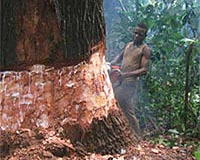| . |  |
. |
Oak Ridge TN (SPX) Jul 30, 2009 After 12 years, an experiment focused on forest growth and climate change comes to an end, and researchers at Oak Ridge National Laboratory are eager to collect and analyze data to see if their predictions match results. With the Department of Energy-sponsored free air carbon dioxide enrichment experiment, known as FACE, three plots of sweetgum trees were the control sites and two plots of sweetgums were exposed to increased carbon dioxide levels in the atmosphere at 550 parts per million, the concentration that is projected to occur in about 2050 if current trends continue. The atmospheric carbon dioxide concentration has been rising steadily because of the burning of fossil fuels and global land use change. Project leader Rich Norby of the Environmental Sciences Division describes the end of the experiment as bittersweet. "In one sense, a project that I have been heavily involved in will no longer be an active experiment site," Norby said. "On the other hand, I am looking forward to gathering the evidence and analyzing the materials to see if our hypotheses prove to be true." Already, researchers and students are sifting through the soil to measure the amount of fine roots and to examine them further. Smaller roots are significant points of study because they take up the majority of the water and nutrients and provide important clues to how forests will respond to higher carbon dioxide in the future. This month, four to five trees per plot are being cut down for analysis. Throughout the experiment, researchers have measured the circumference and height, making projections about the weight of the tree, hypothesizing that increased carbon would lead to increased growth and thus a comparably higher mass. Now, researchers will actually be able to weigh the trees and compare the estimates to actual masses. When considering how the forest stores carbon, trees are often assumed to store the most for the longest. Soil lives longer than trees, though, so some researchers see soil as a more obvious resource for storing carbon compared to wood. Colleen Iversen, a post-doctoral researcher who wrote her dissertation on the FACE project, notes that the trees are cycling carbon through the forest ecosystem faster. "We noticed that in the plots with increased carbon dioxide exposure, the trees are absorbing more carbon, but the trees are also releasing more carbon," Iversen said. "What we are trying to understand is how much carbon is being cycled and how much is being stored." Even before the experiment officially ended, one hypothesis was confirmed when researchers saw that an increase in carbon dioxide leads to an increase in roots growing deeper into the ground. In previous studies, the focus has been on trees absorbing carbon dioxide, but the FACE experiment gives some attention to the fate of carbon in roots and soil. "The carbon dioxide fertilization effect will not solve the problem of climate change," Norby said. "With this research, though, it has become obvious that the effect of carbon dioxide on tree growth needs to be part of the overall calculation of climate change." The FACE project has resulted in more than scientific advances. FACE has been the subject of five theses, several dozen publications and has presented academic opportunities for numerous undergraduate and graduate students and post-doctoral researchers. FACE collaborators have included Argonne National Laboratory, Purdue University, University of Illinois at Chicago and University of New South Wales in Australia. Ultimately, the results that come from comparing the control sites with the elevated carbon dioxide sites will help improve the computer models that make projections of future climate. UT-Battelle manages Oak Ridge National Laboratory for the Department of Energy. Share This Article With Planet Earth
Related Links Oak Ridge National Laboratory Forestry News - Global and Local News, Science and Application
 Greenpeace calls for clear logging policies in DR Congo
Greenpeace calls for clear logging policies in DR CongoKinshasa (AFP) July 28, 2009 Greenpeace has urged authorities in the Democratic Republic of Congo to clarify reforms bringing transparency to the logging sector in the world's second biggest rainforest after the Amazon. The "objective is still far from being reached," the global environment campaign group said in a letter to the minister of the environment, a copy of which was given to AFP on Tuesday. "It is urgent ... read more |
|
| The content herein, unless otherwise known to be public domain, are Copyright 1995-2009 - SpaceDaily. AFP and UPI Wire Stories are copyright Agence France-Presse and United Press International. ESA Portal Reports are copyright European Space Agency. All NASA sourced material is public domain. Additional copyrights may apply in whole or part to other bona fide parties. Advertising does not imply endorsement,agreement or approval of any opinions, statements or information provided by SpaceDaily on any Web page published or hosted by SpaceDaily. Privacy Statement |